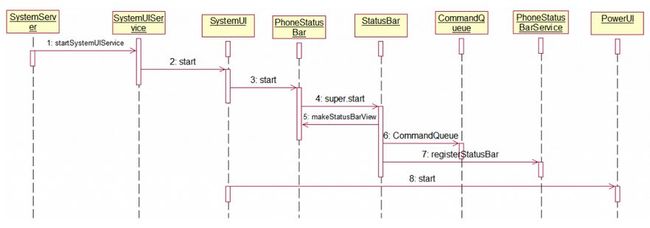5.0systemUI启动流程
5.0SytemUI启动流程:
SystemUI是常驻到Android系统的,所以需要Service。
SystemUIService extends Service ——>在 SystemUIService的OnCreate()方法中——–>((SystemUIApplication) getApplication()).startServicesIfNeeded();进入SystemUIApplication中看看` public void onCreate() {
super.onCreate();
//add by fanguoqing
gInst = this;
// Set the application theme that is inherited by all services. Note that setting the
// application theme in the manifest does only work for activities. Keep this in sync with
// the theme set there.
setTheme(R.style.systemui_theme);
IntentFilter filter = new IntentFilter(Intent.ACTION_BOOT_COMPLETED);
filter.setPriority(IntentFilter.SYSTEM_HIGH_PRIORITY);
registerReceiver(new BroadcastReceiver() {
@Override
public void onReceive(Context context, Intent intent) {
if (mBootCompleted) return;
if (DEBUG) Log.v(TAG, "BOOT_COMPLETED received");
unregisterReceiver(this);
mBootCompleted = true;
if (mServicesStarted) {
final int N = mServices.length;
for (int i = 0; i < N; i++) {
mServices[i].onBootCompleted();
}
}
}
}, filter);
}`
在.onCreate()中注册了一个监听开机的广播当开机完成onBootCompleted(),启动SystemUI。当调用startServicesIfNeeded()时启动
private final Class[] SERVICES = new Class[] {
com.android.systemui.keyguard.KeyguardViewMediator.class,
com.android.systemui.recent.Recents.class,
com.android.systemui.volume.VolumeUI.class,
com.android.systemui.statusbar.SystemBars.class,
com.android.systemui.usb.StorageNotification.class,
com.android.systemui.power.PowerUI.class,
com.android.systemui.media.RingtonePlayer.class
};启动这些类。
public void startServicesIfNeeded() {
if (mServicesStarted) {
return;
}
if (!mBootCompleted) {
// check to see if maybe it was already completed long before we began
// see ActivityManagerService.finishBooting()
if ("1".equals(SystemProperties.get("sys.boot_completed"))) {
mBootCompleted = true;
if (DEBUG) Log.v(TAG, "BOOT_COMPLETED was already sent");
}
}
Log.v(TAG, "Starting SystemUI services.");
final int N = SERVICES.length;
for (int i=0; i cl = SERVICES[i];
if (DEBUG) Log.d(TAG, "loading: " + cl);
try {
mServices[i] = (SystemUI)cl.newInstance();
} catch (IllegalAccessException ex) {
throw new RuntimeException(ex);
} catch (InstantiationException ex) {
throw new RuntimeException(ex);
}
mServices[i].mContext = this;
mServices[i].mComponents = mComponents;
if (DEBUG) Log.d(TAG, "running: " + mServices[i]);
mServices[i].start();
if (mBootCompleted) {
mServices[i].onBootCompleted();
}
}
mServicesStarted = true;
}
mServices[i].start();调用了这些类的start()方法。这些类都是继承自SystemUI.class SystemUI是一个抽象类
public abstract class SystemUI {
public Context mContext;
public Map, Object> mComponents;
public abstract void start();
protected void onConfigurationChanged(Configuration newConfig) {
}
public void dump(FileDescriptor fd, PrintWriter pw, String[] args) {
}
protected void onBootCompleted() {
}
@SuppressWarnings("unchecked")
public T getComponent(Class interfaceType) {
return (T) (mComponents != null ? mComponents.get(interfaceType) : null);
}
public void putComponent(Class interfaceType, C component) {
if (mComponents != null) {
mComponents.put(interfaceType, component);
}
}
} SystemUI抽象了一个start();
PhoneStatusBar继承自BaseStatusBar。BaseStatusBar继承自SystemUI;
那就看看start()
@Override
public void start() {
mDisplay = ((WindowManager)mContext.getSystemService(Context.WINDOW_SERVICE))
.getDefaultDisplay();
updateDisplaySize();
mScrimSrcModeEnabled = mContext.getResources().getBoolean(
R.bool.config_status_bar_scrim_behind_use_src);
/// M: [SystemUI] Support Smartbook Feature. @{
if (SIMHelper.isMtkSmartBookSupport()) {
/// M: [ALPS01097705] Query the plug-in state as soon as possible.
mIsDisplayDevice = SIMHelper.isSmartBookPluggedIn(mContext);
Log.v(TAG, "start, mIsDisplayDevice=" + mIsDisplayDevice);
}
/// @}
super.start(); // calls createAndAddWindows()
mMediaSessionManager
= (MediaSessionManager) mContext.getSystemService(Context.MEDIA_SESSION_SERVICE);
// TODO: use MediaSessionManager.SessionListener to hook us up to future updates
// in session state
addNavigationBar();
// Lastly, call to the icon policy to install/update all the icons.
mIconPolicy = new PhoneStatusBarPolicy(mContext, mCastController, mHotspotController);
mSettingsObserver.onChange(false); // set up
mHeadsUpObserver.onChange(true); // set up
if (ENABLE_HEADS_UP) {
mContext.getContentResolver().registerContentObserver(
Settings.Global.getUriFor(Settings.Global.HEADS_UP_NOTIFICATIONS_ENABLED), true,
mHeadsUpObserver);
mContext.getContentResolver().registerContentObserver(
Settings.Global.getUriFor(SETTING_HEADS_UP_TICKER), true,
mHeadsUpObserver);
}
mUnlockMethodCache = UnlockMethodCache.getInstance(mContext);
mUnlockMethodCache.addListener(this);
startKeyguard();
mDozeServiceHost = new DozeServiceHost();
putComponent(DozeHost.class, mDozeServiceHost);
putComponent(PhoneStatusBar.class, this);
setControllerUsers();
notifyUserAboutHiddenNotifications();
mScreenPinningRequest = new ScreenPinningRequest(mContext);
}super.start(); // calls createAndAddWindows()代码中调用了父类的start(),看看父类中的start()做了什么
public void start() {
mWindowManager = (WindowManager)mContext.getSystemService(Context.WINDOW_SERVICE);
mWindowManagerService = WindowManagerGlobal.getWindowManagerService();
mDisplay = mWindowManager.getDefaultDisplay();
mDevicePolicyManager = (DevicePolicyManager)mContext.getSystemService(
Context.DEVICE_POLICY_SERVICE);
mNotificationColorUtil = NotificationColorUtil.getInstance(mContext);
mNotificationData = new NotificationData(this);
mAccessibilityManager = (AccessibilityManager)
mContext.getSystemService(Context.ACCESSIBILITY_SERVICE);
mDreamManager = IDreamManager.Stub.asInterface(
ServiceManager.checkService(DreamService.DREAM_SERVICE));
mPowerManager = (PowerManager) mContext.getSystemService(Context.POWER_SERVICE);
mSettingsObserver.onChange(false); // set up
mContext.getContentResolver().registerContentObserver(
Settings.Global.getUriFor(Settings.Global.DEVICE_PROVISIONED), true,
mSettingsObserver);
mContext.getContentResolver().registerContentObserver(
Settings.Global.getUriFor(Settings.Global.ZEN_MODE), false,
mSettingsObserver);
mContext.getContentResolver().registerContentObserver(
Settings.Secure.getUriFor(Settings.Secure.LOCK_SCREEN_SHOW_NOTIFICATIONS), false,
mSettingsObserver,
UserHandle.USER_ALL);
mContext.getContentResolver().registerContentObserver(
Settings.Secure.getUriFor(Settings.Secure.LOCK_SCREEN_ALLOW_PRIVATE_NOTIFICATIONS),
true,
mLockscreenSettingsObserver,
UserHandle.USER_ALL);
mBarService = IStatusBarService.Stub.asInterface(
ServiceManager.getService(Context.STATUS_BAR_SERVICE));
mRecents = getComponent(RecentsComponent.class);
mRecents.setCallback(this);
final Configuration currentConfig = mContext.getResources().getConfiguration();
mLocale = currentConfig.locale;
mLayoutDirection = TextUtils.getLayoutDirectionFromLocale(mLocale);
mFontScale = currentConfig.fontScale;
mUserManager = (UserManager) mContext.getSystemService(Context.USER_SERVICE);
mLinearOutSlowIn = AnimationUtils.loadInterpolator(mContext,
android.R.interpolator.linear_out_slow_in);
mFastOutLinearIn = AnimationUtils.loadInterpolator(mContext,
android.R.interpolator.fast_out_linear_in);
// Connect in to the status bar manager service
StatusBarIconList iconList = new StatusBarIconList();
mCommandQueue = new CommandQueue(this, iconList);
int[] switches = new int[8];
ArrayList binders = new ArrayList();
try {
mBarService.registerStatusBar(mCommandQueue, iconList, switches, binders);
} catch (RemoteException ex) {
// If the system process isn't there we're doomed anyway.
}
createAndAddWindows();
disable(switches[0], false /* animate */);
setSystemUiVisibility(switches[1], 0xffffffff);
topAppWindowChanged(switches[2] != 0);
// StatusBarManagerService has a back up of IME token and it's restored here.
setImeWindowStatus(binders.get(0), switches[3], switches[4], switches[5] != 0);
// Set up the initial icon state
int N = iconList.size();
int viewIndex = 0;
for (int i=0; iif (icon != null) {
addIcon(iconList.getSlot(i), i, viewIndex, icon);
viewIndex++;
}
}
// Set up the initial notification state.
try {
mNotificationListener.registerAsSystemService(mContext,
new ComponentName(mContext.getPackageName(), getClass().getCanonicalName()),
UserHandle.USER_ALL);
} catch (RemoteException e) {
Log.e(TAG, "Unable to register notification listener", e);
}
if (DEBUG) {
Log.d(TAG, String.format(
"init: icons=%d disabled=0x%08x lights=0x%08x menu=0x%08x imeButton=0x%08x",
iconList.size(),
switches[0],
switches[1],
switches[2],
switches[3]
));
}
mCurrentUserId = ActivityManager.getCurrentUser();
setHeadsUpUser(mCurrentUserId);
IntentFilter filter = new IntentFilter();
filter.addAction(Intent.ACTION_USER_SWITCHED);
filter.addAction(Intent.ACTION_USER_ADDED);
filter.addAction(BANNER_ACTION_CANCEL);
filter.addAction(BANNER_ACTION_SETUP);
filter.addAction(DevicePolicyManager.ACTION_DEVICE_POLICY_MANAGER_STATE_CHANGED);
mContext.registerReceiver(mBroadcastReceiver, filter);
updateCurrentProfilesCache();
} 父类中的start()做了一些初始化操作,看createAndAddWindows();这个是一个抽象方法,那到子类中看看具体做了一些什么。看
@Override
public void createAndAddWindows() {
addStatusBarWindow();
}
private void addStatusBarWindow() {
makeStatusBarView();
mStatusBarWindowManager = new StatusBarWindowManager(mContext);
mStatusBarWindowManager.add(mStatusBarWindow, getStatusBarHeight());
}
加载StatusBar,—->初始化布局控件并加入到view中,还有注册了一些广播,最终会返回PhoneStatusBarView。PhoneStatusBarView是一个FrameLayout。
mStatusBarWindowManager = new StatusBarWindowManager(mContext);
mStatusBarWindowManager.add(mStatusBarWindow, getStatusBarHeight());这里将会把Statusbar交给mStatusBarWindowManager去管理,StatusBarWindowManager是一个系统服务。
回到父类BaseStatusBar的start()往下,就会看到注册了通知的系统管理。继续往下,就会进入到子类的start();
addNavigationBar();加入导航栏,初始化了导航栏一些监听事件
并通过 mWindowManager.addView(mNavigationBarView, getNavigationBarLayoutParams());交给WindowManager去处理
。
看看启动时序图